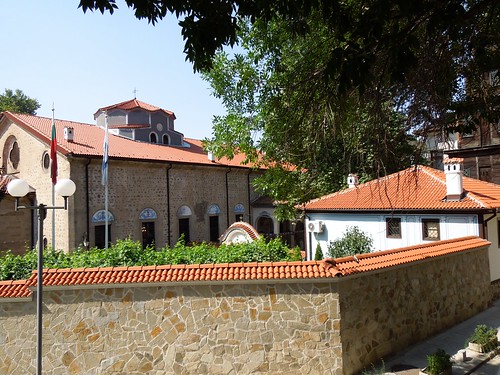Katherine's and my daily routine while we were living in our villa in Bulgaria, was to find a place for a late lunch. We fell in love with Nessebar. Nessebar is about a 10 minute drive from our house. Nessebar is a small piece of land embraced by the sea, connected with a narrow rope-like neck. This small island boasts the finest collection of 19th-century timber homes on the coast, as well as the largest collection of Byzantine-influenced churches. Exploring the tiny port, Old Nessebar, is a wonderful experience.
The Nessebar Peninsula was populated more that 3,000 years ago, at the end of the Bronze Age. The ancient Thracians named it Melsambria; at the end of the 6th century B.C., the first Greek colonizers arrived; in 72 B.C. the town was conquered by the Romans. The first time the town becam part of the Bulgarian state was in 812 A.D., when Khan Kroum conquered it and populated it with Slavs and Bulgarians.
Of all of the treasures Nessebar possesses, the medieval churches are spectacular. The town is called "Bulgarian Ravenna" and "The Pearl of the Orthodox world". Forty churches were on this small island, ten of them are still preserved and restored. They serve as a visual textbook of the religious art as a whole.
St John the Baptist Church
St John Aliturgetos Church
PLOVDIV AND THE VALLEY OF THE KINGS
Five thousand years ago the central plains of Bulgaria, stretching from the foothills of the Balkan mountains to the heartlands of the Rhodoes, home to the Thracian tribes, is said to be Europe's first civilization, whose gold and silversmith techniques were the most sophisticated of ancient times. It is in this area that the richest archaeological finds have been discovered. Gorgeous Plovdiv is still the jewel in Bulgaria's crown. The city flourished under Roman rule. The Roman theatre, is the largest outside of Italy.
Plodiv experienced its second heyday during the late 17th-19th centuries, when the wealthy merchants built beautiful town houses in the best urban examples of the style known as the National Revival - or Bulgarian Baroque. The cobblestone streets of Old Plovdiv meander past Roman ruins,imposing mosques,cool church courtyards, and beautifully painted facades and terraced architecture of these National Revival homes.
Plovdiv is the "Cultural Capital" of Bulgaria. In 1956 Old Plovdiv was declared an architectural-historical reserve and in 1979 it was awarded a gold European medal for its achievements in the preservation of historical monuments.
Antique Stadium. Imposing remains of the stadium were found beneath the street. Thje seats arranged in 14 marble amphithetrical rows stand on supports decorated with high relief lions' paws. 2nd-4th century the stadium was the venue of traditional athletic games organized in honour of the god Apollo and Alexander of Macedon.
Jumaya Mosque. Major Muslim temple in Plovdiv. Ottomans conquered the town in 1371 they build this mosque. It is one of the oldest Ottoman temples on the Balkans and one of the largest in Bulgaria.
The Holy Virgin Cathedral. Dedicated to the Assumption has existed in Plovdiv since 9th century.
St. Constantine and Helena Church. Remarakable antique and Revival architectural complex. The church is a holy historic place and a monument to the talent of some of the most outstanding builders, carvers,icon and mural paingers of Bulgaria.
Revival Period Architectural Ensembles.
Old Plovdiv has rows of Revival Period private and public buildings. The eminent Bulgarian ethnographer and a specialist in the history and customs of the Rhodope Mountains -Stoyu Shishkov laid the beginnings of the museum in 1917. The building covers an area of 5,800 square feet. Exquisite line of the numerous windows and the frescoes on the facade make the entry in to the drawing room on the first floor, a beautiful entry. Your eyes are drawn to the rich wood carving in the ceiling. The house is a credit to the talent of the master builder and advanced European oriented taste of the rich Plovdivian. The owner of the house , Argir Kuyumjioghlu had it built in 1847 by Haji Georgi Hajiiski.
Hebros Hotel. This is where Katherine and I stayed. Once the place where top Communist party members stayed when visiting Plovdiv, the opulence of the materials and the craftsmanship displayed in this typical National Revival home are matched by the furnishings. Bulgarian antiques; windows draped in heavy velvet, and lace; dark varnished flloors with rich Oriental rugs; and walls decorated with traditional frescoes, made this hotel a wonderful place to stay to capture the spirit of Plovdiv.
BACHKOVO MONASTERY
A 30 minute side trip from Plovdiv.. The monastery was founded in 1083 by the two brothers Grigoriy and Abasiy Bakuriani. This is Bulgaria's second largest monastery, and a UNESCO site. Inside the walls is the principal Church of the Assumption of Our Lady (1601) .Beautiful frescos aand a 14th century Virgin Mary icon, said to be a portrait pained by the apostle Luke. The refectory is where there wre murals of the grat Greek philopophers. There are still 10 monks living and working in the monastary. There have never been more than 64 here at its peak.
DON'T FORGET KATHERINE'S BLOG.....texangirleatingdrinkingeurope.blogspot.com
































































No comments:
Post a Comment